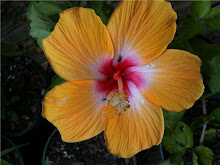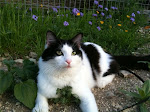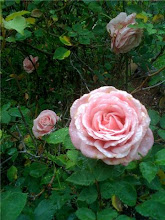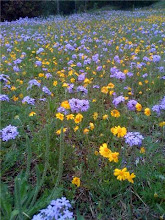Just returned back to Texas from the 10th International Herb Symposium held on the Wheaton College campus in Massachusetts. The campus was just beautiful….so many beautiful trees in bloom, rich lush plants, and lovely ponds. Rosemary Gladstar, dubbed the fairy godmother of plants and herbalists alike, is behind this educational and spiritual movement furthering our deep appreciation of medicinal plants. The herb symposium not only brings together herbalists from all over the world; it also benefits the nonprofit organization, United Plant Savers, she lovingly founded.
Speakers included Susun Weed, Michael Tierra, David Winston, Phyllis Light, Michael Friedman, Mark Blumenthal, Paul Stamets, CoreyPine Shane, Todd Elliott, Margi Flint, jim mcdonald, and many others.
Opening Ceremonies welcomed herbalists far and wide. Attendees entered into a beautiful chapel on campus; opening our hearts with Hawaiian, Native American, and Shaman chants and prayers. White sage purified all who entered this sacred space. With joy in our hearts we were off to further or knowledge of medicinal plants and herbs.
I’ll only feature a couple of classes in this entry, but keep in mind the amount of information received in this 3 day conference was intense! Also, stay tuned for a special guest blog entry from herbhusband! He concentrated on medicinal mushrooms and their benefits to our ecosystem as well as on the amazing work of the honey bee.
The Dirty Dozen: 12 plant roots and their benefits with Matthias and Andrea Reisen of Healing Spirits Herb Farm and Education Center.
When I decided to take this class, I thought we would pass around baskets of dried and fresh roots and review their common uses, etc. Then, I see Andrea Reisen clinging to a pitch fork and the very tall Matthias telling us all – we are going to have class, but it won’t be in here! Off to the campus landscapes we go! The goal? To find 12 plants known for their medicinal qualities, specifically their roots, naturally growing on and around campus. Here are some of the plants we found:
#1)Dandelion(Taraxacum officinale)
Dandelion is often considered a "weed" and found along roadsides and in lawns throughout the United States. However, if you have a pesticide free lawn, instead of discarding this plant, harvest it and utilize it for its nourishing properties. Dandelion is high in vitamins A and C. Newer leaves can be eaten in fresh salads. Aerial parts of the plant can be tinctured and taken as a bitter to aid liver function and digestion.
The root can be eaten fresh, sautéed with olive oil and salt/pepper and makes a delicious side dish. It can be dried and infused and sipped on as a coffee substitute. This is a wondrous gift we have growing all around is, it's time we celebrate dandelion and find room for it in our daily lives.
#2)Barberry
Barberry's woody root and stems contain alkalines, most beneficially, berberine. Berberine has anti-inflammatory and antimicrobial properties. When the woody exterior is scraped off with a knife, the inner bark reveals the bright yellow color synonymous with berberine. The more tender roots can be scraped, dried 75-80 percent and tinctured.
#3) Poke Weed
Poke is listed in many books as poisonous, but when you talk to seasoned herbalists, they tend to see the benefits of this plant and appreciate its properties. Touching the root can cause contact dermatitis in some people. I tend to be a sensitive person and I held the root without any side effects from the direct contact. Matthias says to dig it up in early spring or fall, before or after the bloom stalk so all the energy is restored in the root. Some herbalists have used is assisting with tumors and lymphatic flow since it's considered a lymphatic mover.
#4) Greater Celandine (Chelidonium majus)
Member of the poppy family offering yellow blooms (bi-annual). The whole plant can be used - dry it, grind it and tincture it since it's too strong to drink as a tea. The "orange blood" that comes from breaking off a piece of the root can be applied directly to warts on the skin. This plant likes to grow along the edges of wooded areas and prefers part sun and part shade.
#5) Solomon’s Seal
Andrea says this is, "The candy of the root family....It's like the earth is giving you its sweetness. When you eat it it's like being wrapped by mother earth". Solomon’s Seal is good for ligaments. Andrea gave an example of a dog who had been hit by a car and the dog's jaw was misaligned. Worried the owner dropped some Solomon’s Seal tincture under the dog's tongue and on the way to the vet the jaw had moved back into place. The effect it has on ligaments is why this can be an herbal favorite. The best way to harvest this plant is to take some of the root and replant the plant along with the nodes and it will grow back in its place. Prefers to grow in shade under trees.
#6) Japanese Knotweed
Also known as "Mexican Bamboo" this plant is considered evasive and hard to control once planted. Smaller rhizomes can be used since the larger ones are too hard on blenders and machines when attempting to break it down. It's said this root is used in Lyme disease remedies as well as in cancer since it is said to build up the immune system. People prefer to take it along with a mucilaginous plant since Japanese Knotweed is astringent and drying. Harvest early spring or fall when most of the energy of the plant returns to the roots.
#7) Mullein Root
Mullein is a bi-annual and best harvested when not in flower. Mullein root has been used with older people who have trouble with urinary incontinence. It can be made as a tea or tincture and it was discussed during the walk that it would be ideal for nursing homes to serve as a tea. David Winston also uses it for face pain associated with Palsy.
Adaptogens: Herbs for Strength, Stamina and Stress Relief with David Winston
"What herbalists (know) is too good to be kept in a corner some place - there are so many things we can do to help medicine work better. Specificity must increase among herbalists. Good herbal medicine is to learn to treat the person not the disease. Stop thinking about diseases and start thinking about the plant, the person and the timing." David Winston
The idea of adaptogens dates back to around 1947 and was coined by Dr. Breckman who defined adaptogens as plants with non specific, general operation which have a normalizing effect on the body with little to no side effects. Breckman is considered the "father of adaptogen research".
Adaptogens, taken over time, assist with a wide variety of conditions but specifically increases our body's ability to deal with stresses and conditions our body to have a more appropriate response to the stress.
David Winston was emphatic about herbalists needing to boost their knowledge of how herbs work within the body; increasing the science element in addition to the work herbalists are doing around the world.
All adaptogens have antioxidant activity but not all antioxidants are adaptogens.
Panossian expanded research on what adaptogens do. Panossian and Wagner found a cellular mechanism for adaptogenic activity. Adaptogens activate chaperone molecules know as heat shock proteins (this inhibits the mitochondria and ATP production). Essentially, what occurs is the "engines of our cells" become more effective in responding to stress hormones released in the body. Adaptogens prime the body and prevent the effects of stress from damaging our cellular machinery.
Microbial endocrinology found increases in stress hormone levels can cause us to be more susceptible to infection and disease. Adaptogens can help prevent bacterial infections by decreasing cortisol levels.
David Winston discussed these well researched adaptogens in class:
- American Ginseng root (Panax quinquefolius)
The wildcrafted root is endangered. Please avoid promoting and harvesting and only purchase by ethical plant growers. American ginseng is neutral and warming. Good for adrenal exhaustion.
- Ashwagahdha root (Withania somnifera)
This can be grown in the US. It's an annual and in one year, it produces a good root to harvest from. Likes hotter drier areas in the garden. If you can grow tomatoes, peppers and eggplant, David says you can grow this plant.
Native to India, it is one of the calming adaptogens and used by many to assist with generalized anxiety disorder. Used also for autoimmune muscular conditions where the connective tissues and muscles are affected. Not to be given to people with hyper thyroid or anyone on thyroid medications. It is high in iron.
- Asian ginseng root (Panax ginseng)
This root comes in two forms: red and white. The white has been dried and the red has been steamed. Red is more stimulating and white is warming. This root is really too stimulating for most people, so the American ginseng is better suited. Asian ginseng really shouldn't be used by most people since it is over stimulating. This root is reserved for those who are completely depleted and exhausted to the point they can't function at any point in the day. Winston says it's been used for old men to build up vital energy.
- Eleuthero bark (Eleutherococcus senticosis)
Used mostly for younger people under temporary stress. It is one of the mildest adaptogens. Best in fluid extract. It is good for stressed out Type A's and good when taken over time. I'm actually taking this now (as I'm a renowned stressed out Type A, lol) and after about a week, I really started feeling brighter. I'm also easily over stimulated so I wanted to start with a milder adaptogen. I'm very happy with my Eleuthero tincture.
- Licorice rhizome (Glycyrrhiza glabra, G. uralensis)
Increases potassium and decreases sodium in the body when taken. Good in small amounts. Helps with irritated bowels from IBS or IBD. Good for dry coughs and animal dander sensitivities.
- Holy basil (Ocimum sanctum, O. gratissimum)
Mildly stimulating, enhances focus and decreasing brain fog. Winston referred to this herb as "lovely". He also said it is taken to assist with seasonal allergies, stagnant depression or situational depression that becomes permanent due to an event that a person can't seem to get past. Good with rosemary and rose petals for instances like this.
As you can see, the herb symposium was full of informative speakers and nonstop entertainment. Other activities included morning yoga, summer solstice celebration, product making contests, all you can drink herbal teas, a cookie social and book signing, the sweet sounds of Rising Appalachia, keynote by Paul Stamets of "Fugni Perfecti" and so much more.
It was really fun to attend the International Herbalists Ball with the Eames Brothers Band. A special Kava punch was served, a specialty by Rosemary Gladstar, and everyone was having a sensational time.
If you ever have an opportunity to attend this event, or any other herb conference, you'll surely have a great time!
Autumn's Bounty
1 month ago
























+and+wildflowers+loving+the+field.jpg)








No comments:
Post a Comment